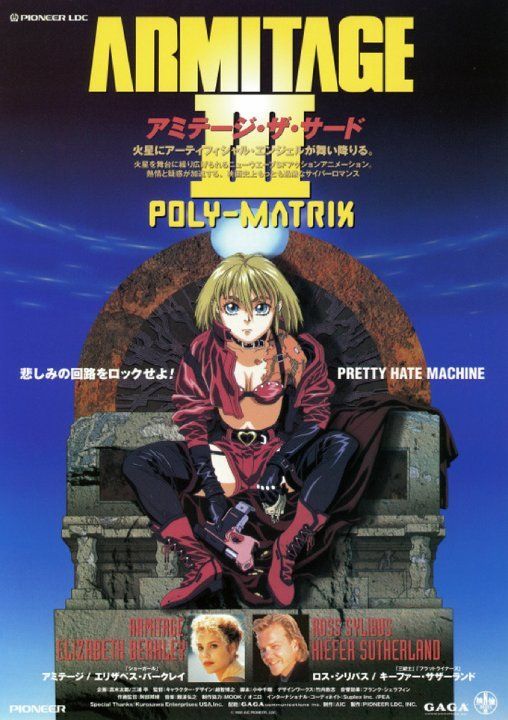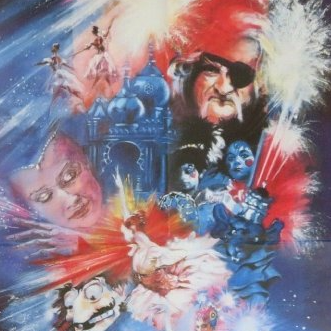Armitage III: Poly-Matrix
# In the Year 2046 / If man can still… Well, you know.

Japanese poster | Gaga Communications
1996 — Japan/USA
An AIC production, in cooperation with KUROSAWA ENTERPRISES USA, MOOK, ONIRO and SUPLEX; presented by PIONEER ENTERTAINMENT and PIONEER LDC
Voice cast: ELIZABETH BERKLEY and KIEFER SUTHERLAND, with DAN WOREN, WANDA NOWICKI, MIKE REYNOLDS, BARRY STIGLER and BRYAN CRANSTON
Director: HIROYUKI OCHI
Producers: KAZUAKI MORIJIRI, HIDEMI SATANI and TAK W. ABE
Executive Producers: NAOJU NAKAMURA and TORU MIURA
Original screenplay: CHIAKI KONAKA
English script: MARY MASON and QUINT LANCASTER
Editing: TERUMITSU OKADA and SHIGEYUKI YAMAMORI
Photography: HISAO SHIRAI
Character designer: HIROYUKI OCHI
Animation direction: KUNIHIRO ABE, KOICHI HASHIMOTO, SHINYA TAKAHASHI and NAOYUKI ONDA
Art direction: TAKUHIRO HIRAKI, JUN OKABE, MASARU SATO and HIROSHI KATO, with MASAHIRO SATO
Music: HIROYUKI NAMBA
English ADR direction: KEVIN SEYMOUR
© Pioneer Entertainment (USA) L.P. / Pioneer LDC
© AIC / Pioneer LDC
Future year 2046! Ross Sylibus (Voice of Kiefer Sutherland), a Chicago police detective, has put in to transfer to Mars to escape his traumatic past, as you do. Upon arrival, there’s an however, there’s an incident… like, immediately. His upcoming new partner, the waifish Naomi Armitage (v/o Elizabeth Berkley) of the Mars Police Department is chasing a perp through the spaceport, a perp who becomes increasingly obvious when his suitcase starts trailing blood. On the same flight, the “last country singer in the universe” Kelly McCanon is set to arrive on Mars. Wouldn’t you know it, she’s in the suitcase, quite dead. Our suspect, as he’s rather generously referred to, is one René D’Anclaude (v/o Dan Woren); he escapes in the kerfuffle when the case falls open causing her to flop out over the terminal floor. He apparently remains the ‘suspect’, even as he sends a video to the news graphically showing him killing her. On the other hand, it seems she was in fact a robot indistinguishable from a human in terms of appearance, thoughts and emotions, and anti-robot sentiment is already through the roof of late… so he also leaks a list of these ultra-human seeming robots and letting the public do the work. Due to this public element, the filth isn’t especially enthusiastic in their pursuit, apart from Armitage, that is. She is also one of these fancy nigh indistinguishable robots, the third model of Martian robots; the prototype no less, being the ‘daughter’ of the planet’s swankiest roboticist. This is on the DL, obviously, though you’d think her being a super strong and also looking like a teenage girl would be a dead giveaway. As such, she has somewhat of a vested interest in tracking down who’s killing the other thirds in a not-so-subtle Blade Runner style, as well as finding out both why he’s killing them and also why they’ve built ridiculously human robots in the first place. The mystery of the thirds’ raison d’être is complicated further; McCanon’s autopsy reveals that she was so human-like that she was actually pregnant.
So, the nitty gritty… this is a compilation movie, combining the original four-part Armitage III OVA series (1995) into a single 90-ish minute feature. An OVA, for the uninitiated, is an ‘original video animation’ (occasionally you’ll see them called ‘OAVs’ instead, the letters still mean the same thing though). They’re anime productions that were released directly to video rather than airing on TV or screening in cinemas (well, usually; it wasn’t unheard of for them to see a limited theatrical release), and the form they took could vary; while there are some OVAs that are essentially feature length films, there are many that emulate the format of a TV series with shorter episodes spread across multiple tapes released theoretically every month or two. Given the nature of the distribution method, production values tend higher than TV animation (and they’re not necessarily constrained by time slots either), but if it fails to catch the market fairly quickly invariably the plug will be pulled leaving the story incomplete (often with a ‘next episode’ preview taunting those who did buy into it). For much of the ‘80s and ‘90s, this was pretty much the main way anime aimed at non-children-and-family markets was marketed; in 1995, Neon Genesis Evangelion (1995-1996) is often deemed to have pretty much revitalised TV as a trendy and viable medium for more… experimental (shall we say?) projects, though it seems like it really took off, and spelled the death knell for that kind of OVA, with the rise of late night anime a few years later (Evangelion aired at tea time on a Wednesday). OVAs do still stick around though, mostly as a promotional tool either in the form of extra unaired episodes on home video releases of TV shows or as bonuses with first printings of collected volumes of popular manga.
While it wasn’t remotely uncommon for OVA series to get spliced into a single entity by foreign distributors, usually by just cutting the various title sequences and then running all the episodes together, this is the true type of compilation film, where they re-edit and abridge it to a sensible theatrical film length and add in new footage to help it flow together better. I say a ‘sensible’ theatrical film length, but the original series apparently clocks in at like 140 minutes all told, which honestly doesn’t seem that far out in the scheme of things, but, well, here we are, this has like 50 minutes cut out. Maybe someone declared cutting it to two hours would still be too long, cut it more, MORE! Hmm… actually… well, we’ll get to that.
One of the elephants in the room here is, of course, Ghost in the Shell (1995). I’ve seen it posited that Armitage III exists for the sake of capitalising on Ghost in the Shell’s success. This seems debatable. The first episode of the OVA came out a good seven months before the Ghost in the Shell film’s festival premiere, and the last about a week after it went on general release, so it seems unlikely it was a direct ‘Me Too’ capitalisation… also the Ghost in the Shell film was famously a massive bomb in Japan. With that said, the characterisation of Armitage herself does seem to reflect, to the best of my knowledge, the sort of characterisation Major Kusanagi has in the original GitS manga where she’s not always on. I still haven’t read that, so I can’t really comment properly. This film version however definitely seems to exist to capitalise on those sorts of things, being produced pretty much entirely with the international (read: Anglophone) market in mind,† where those things were not only successful but managed to cross over into the mainstream market to a degree that little Japanese animation had; Japanese releases of this film maintains the English voice acting rather than (re)dubbing it back into Japanese. I can imagine someone at Pioneer LDC, seeing how western audiences went for GitS, realising they had something sort of similar, and rubbing their hands with glee. Or perhaps not, as this incarnation first materialised in Japan in the April of 1996 which, even with the bulk of the animation recycled from the OVA, doesn’t seem long enough to get all the various pieces of production involved; the re-editing, the new footage, the translation, the dubbing, etc.; in place. The Ghost in the Shell connection becomes tenuous when the US release was that March (the UK got it earlier, in December), and is generally deemed to not have become a thing until it was released on video that summer. In short, I don’t know. Maybe they were just banking on catching the Akira (1988) crowd. (That along with perhaps the most obvious reason for an OVA compilation movie; to nab the money of people who didn’t want to pay the better part of ¥100k a piece for a series of laserdiscs each with thirty odd minutes of content.)
Well, that was a whole lot of words about nothing. Let us to the point. Given the nature of the production, suffice to say, the values do not measure up to the main theatrical competition in the cyberpunk field… which I guess was really just Ghost in the Shell and Akira so far as English-speaking markets were concerned at that point.‡ While, as suggested earlier, as an OVA the production values exceed those of TV anime, they fall short of big budget animated films. Obviously, that’s not to say that they’re bad; it does fall into a fairly pleasant mid-range level, but there are places where corners are very obviously cut and pennies have been very obviously pinched in order to make it come in at a reasonable price, with more uses of limited frames and a somewhat rougher, sketchier look to the artwork. A bigger tell that something’s amiss is the pacing. The whole thing is a regular roller coaster of peaks and troughs that belie its original serial nature. Cutting out nearly an hour seems to have, perhaps unsurprisingly, done a number on much of the actual plotting, even with attempts to patch it up, but it hasn’t done much to disguise the clear breaks in the narrative; you can spot exactly where the first episode is meant to end and can make a pretty good guess as to the second. I suppose this was a peril of OVA series; before the series had proven itself, you wanted individual episodes that could potentially stand on their own but that had enough set up to develop on should you get the go ahead to continue.
I wonder if there are animation cels and that from incomplete episodes of cancelled OVAs out there?
The presumed nod to the American market comes in the much ballyhooed in the promotional materials casting of Kiefer Sutherland and Elizabeth Berkley as the leads, though I doubt either of them were that much of a draw in the mid ‘90s. (I suppose they were at least more relevant than when Bandai tried to make out casting Stacey Q in the English dub of Stratos 4 (2003) was a massive coup.) One of them is fairly decent, the other is shiiiiiit. It’s not the one you think! Sutherland turns in a vocal performance that is quite staggeringly bad, and I can only assume they were too giddy at having a noteworthy film star at a lull in his career to tell him to redo lines, and so Ross Sylibus speaks in a bored and confused seeming flat affect regardless of what’s going on. I’m making assumptions here; perhaps someone, maybe even the same someone, was there during recording being all ‘no, no, less emotion, LESS!’ Sometimes it seems appropriate, but oftentimes it’s just bizarre. Contrast this with Berkley, fresh off of Showgirls (1995), who is most definitely trying to bring together the vaguely paradoxical elements of the title character into a coherent performance and more-or-less succeeds. She certainly manages about as well as the remainder of the non-Sutherland cast, which comprises almost entirely of regulars from the anime dubbing scene of the day (yes, even Bryan Cranston).
Sutherland gets a bonus ‘special thanks’ credit for some reason.
Ordinarily, I wouldn’t start talking spoilers, but, well, I kind of have to here, so I’m going to have to put the conclusion before the end. A description I saw of this film was that it was like Ghost in the Shell but trashier. I can sort of buy that. The trashiness is presumably amplified a bit by the removal of a whole heap of footage; I assume they wanted to get to the action quicker, foreigners like the action bits, don’t you know, hence the extent of footage that’s gone AWOL, but at the same time, there’s quite a bit of interesting meat on it. It functions as a bizarro Pinocchio story, or Armitage as a grimdark Cutey Honey, and pops some interesting questions with regard to humanity and that, though it is flagrantly aping Blade Runner on that front. Now stop reading, as I’m about to discuss said meat. I’ve italicised it so you can tell if you’re skipping to the footnotes.
So the other elephant in the room, the one I alluded to there being earlier… The reveal is that the killings are, naturally, a result of a conspiracy, but the nature of the conspiracy is… one of the thing’s more controversial elements. In essence, the basis is that the human colony of Mars has failed. You see, there has been a mass influx of male immigration to the colony but relatively few female takers. This boils down to women’s increasing status on Earth, as exemplified by the leader of the Earth government being a woman whose look seems patterned after Thatcher (like all female politicians in media), meaning that Mars is a hot location for Men’s Rights separatists. Somehow women aren’t big on moving to a society that values them less; go figure. As such, the birth rate is pretty much non-existent and colony collapse looks inevitable. The Thirds are developed as a potential replacement for human women. The Earth government isn’t too keen on Mars making its own women, so they’ve offered the ultimatum of destroy the ‘fakes’ and join the Earth union, play by its rules, etc., and they’ll ensure Mars survives, or don’t do that and have Earth declare a war that Mars can’t possibly win. The controversy here largely stems from the bandying about of the word ‘feminist’ to describe the Earth government, which results in the question ‘is this all some anti-feminist polemic?’ The director denies having intended to grapple with social issues at all, but they do rather permeate the whole thing, not least with the Thirds being coded as a minority group. You can find people arguing one way or the other on the issue. Given the culture of Japan at the time, when it was apparently popular to blame declining birth rate on feminism telling women they can do things other than be mothers and housewives; that Armitage is following that logic would be a coherent line of thinking. Other than the eponymous heroine, the Third women we see (in the film edit; I believe more turn up in the original series) all fit into ‘acceptable’ arty feminine jobs. On the other hand, even beyond Armitage’s far from meek behaviour, there’s not really much evidence to suggest that they are the sort of wife-and-mother types that a misogynistic society would approve of; other than McCanon’s apparent pregnancy, we don’t really see any evidence of them living for traditional gender roles at all, instead just living as ordinary people (furthermore, the most prominent Thirds in the supporting cast are the lone male one, whose existence raises more questions, and the one coded as a lesbian). As has been pointed out, simply saying that a thing is something doesn’t make it so. There are only a handful of Thirds, the project having seemingly been discontinued, how much of a threat are they? Mars seems to have much bigger problems from a feminist perspective than a few people living their lives as ordinarily as they can; in context, the Third are at worst a symptom, not the cause of Mars’ problem with women; but, fuck it, this is the hill they want to die on instead. There are always people willing to pull up the ladder after them, because some sub-groups within groups are apparently worth more than others.
What do I think? Hmm. That I don’t know. Sorry to be inconclusive, but, well, what are you going to do?
† Despite how I’m making this sound, the original series did come out in English, before this incarnation even. It doesn’t feature Sutherland or Berkley, but the rest of the dubbed cast is more-or-less the same.
‡ I think
Silent Möbius (1991) and the original two
Megazone 23 films (1985 and 1986) might have hit America by then, and I think weird anthology
Manie-Manie (1987) probably counts, though I’m not sure any of those made that big a splash overall… I suppose I’m ignoring a lot of popular non-cyberpunk stuff, but, well, you know.
At time of writing, Armitage III: Poly-Matrix is NOT available to rent on any major online service. I recommend JustWatch for keeping up with where films are streaming (including this one!); that said, though they do list Funimation as having it available for streaming, the UK service doesn't seem to. Alternatively, physical copies are reportedly available for rent via Cinema Paradiso.
The film presently has an 18 rating (last submitted in 1998), which predates them giving details, blah blah blah. Honestly, none of the content seems all that graphic compared to a lot of the trash that was getting brought over in Manga's early '90s heyday, or even stuff now (not just in anime, like generally), so I'd be surprised if it'd still get an 18 if they resubmitted. (Curiously, the original OVA series version is actually rated 15 (last submitted between 1995 and 1996).) There's a bit of blood, some brief shots of bare breasts, that kind of stuff.
Sources
Hewis, M., 2018. '#66: Armitage III - Poly-Matrix (1997)', 1000 Anime, [online]. Available at: <http://1000animelist.blogspot.com/2018/09/66-armitage-iii-poly-matrix-1997.html> [Accessed 28 June 2021].
'corbeaukarasu', 2011. 'Armitage III: Is Feminism the Enemy?', A Poisoned Book, [online]. Available at: <https://apoisonedbook.wordpress.com/2011/12/20/armitage-iii-is-feminism-the-enemy/> [Accessed 28 June 2021].
'Spanglypants McFuckyou', 2018. 'Armitage III, "Fake Women", and the Anti-Feminist Accusation', Pretty Hate Machine, [online]. Available at: <https://web.archive.org/web/20180102155815/http://spanglypants-mcfuckyou.tumblr.com/post/89804180330/armitage-iii-fake-women-and-the-anti-feminist> [Accessed 28 June 2021]. Archived from the original.
The Conception Clearinghouse, [20??]. A Feminist Reading of Armitage III, [online]. Available at: <https://conceptionclearinghouse.wordpress.com/essays-and-articles/a-feminist-reading-of-armitage-iii/> [Accessed 28 June 2021].
…Well, I probably wouldn't recommend hanging around these places too much.



